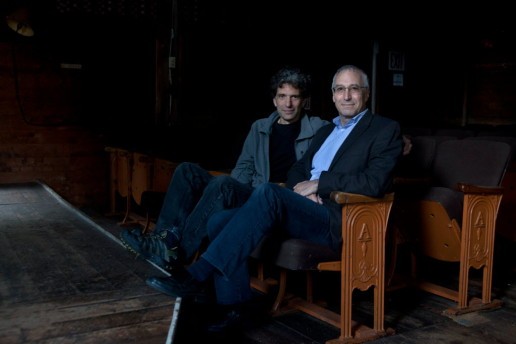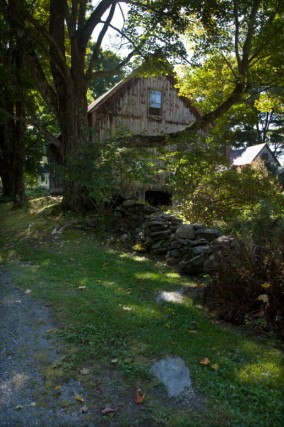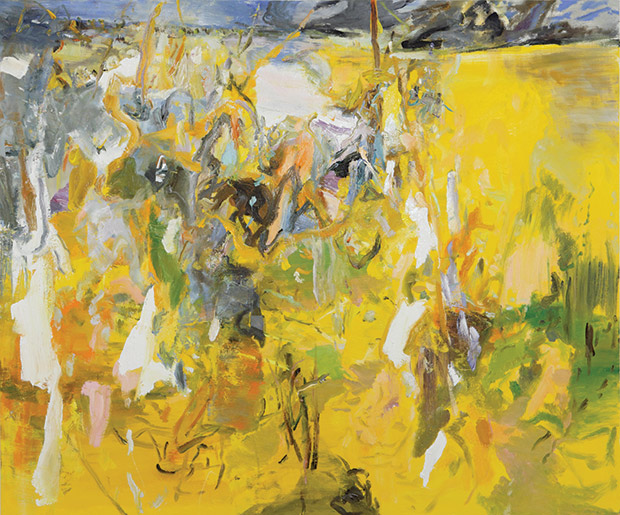O Moon of Alabama: A Kurt Weill Cabaret
Actor and creator Walter Van Dyk speaks about the work he will do at Yellow Barn during an Artist Residency this May:
The idea really started way back in 1980 when I saw Alvin Epstein and Martha Schlamme perform Kurt Weill together at the Loeb Drama Centre in Cambridge, Massachusetts. Alvin had just directed me in the American Repertory Theatre's production of A Midsummer Night's Dream and I also stayed on to do Brecht and Weill's Happy End in the same season. It took about 10 years before I decided to put my own compilation show of Weill's songs together, and it kicked off a relationship with performing Weill songs over the past 20 years.
Originally the Kurt Weill Cabaret which I devised was with a pianist and three other actor/singers, and the first performance took place on the London fringe in a suitably grotty pub theatre. We received such excellent notices by the London press that we ended up being asked to perform it by David Thacker at the Young Vic and taking it to Amsterdam for a three week run at the Stadsschouwburg.
After we disbanded, I met Liza Sadovy when we performed a German cabaret together called Send for Mr. Plim by Mischa Spoliansky (a contemporary of Kurt Weill's). At the time, I had said to Liza that I wanted to revive the Kurt Weill, and would she be interested in joining me as a duo. To my delight, she accepted and we ended up performing it in the West End, and also most recently in the UK at the Birmingham Repertory Theatre.
Every time Liza and I come back to the show, we enjoy discovering new layers. As we've always performed the evening with just a pianist, we were completely thrilled at Seth Knopp's suggestion of doing this compilation show of Kurt Weill songs with a full ensemble comprising nine Yellow Barn musicians. Michael Haslam, our pianist and collaborator over the years, is currently making arrangements of all the songs specifically for this ensemble of musicians. We are all extremely excited at the prospect of mounting this performance of O Moon of Alabama: A Kurt Weill Cabaret in the United States, first in Putney and then in Dallas. We hope that as many people will come from miles around to celebrate and appreciate these stunning songs by one of the truly great cabaret composers, Kurt Weill.
Find out more about this residency performance
Song list:
Overture to The Threepenny Opera
Mack The Knife from Threepenny Opera
Barbara Song from Threepenny Opera
Liebeslied from Threepenny Opera
Tango Ballad Threepenny Opera
Alabama Song from The Rise and Fall of the House of Mahagonny
Herr Jacob Schmidt from Mahagonny
Pirate Jenny from Threepenny Opera
My Ship from Lady in the Dark
September Song from Knickerbocker Holiday
That's Him from One Touch of Venus
Tchaikovsky from Lady in the Dark
Moon Faced—Starry Eyed from Street Scene
Surabaya Johnny from Happy End
Lonely House from Street Scene
Sailor's Tango from Happy End
Bilbau Song from Happy End
From Vermont and Baltimore, to Dallas
Mental Notes (photographs by Nan Coulter)






FD, the lifestyle magazine of the Dallas Morning News, profiles Yellow Barn's Artistic Director, Seth Knopp, who also serves as Artistic Director of Soundings: New Music at the Nasher. Now in its fifth season, Soundings is the cornerstone of an ongoing collaboration between the Nasher and Yellow Barn.
View the printed version of this article as a PDF
If you put together the words serious music and Dallas, the first things you may think of are the Dallas Symphony Orchestra in the acoustically perfect Meyerson, or the Dallas Opera in the lipstick-red Winspear.
Try to think a little differently.
You can be in the Arts District and skirt the glamour of the big venues and their more traditional programming. Seth Knopp, of the chamber music and piano faculties of the Peabody Conservatory of Johns Hopkins University in Baltimore and of the Yellow Barn Music School and Festival in Putney, Vermont, is a pianist. He is also a distinctly un-Dallas-like fellow. Soulful, Jewish, intellectual: He’d be more at home on Manhattan’s Upper West Side or in Brooklyn than in Dallas’ glitz. But since 2010, Knopp has been the man behind the most innovative, quirky music series in this city. Soundings: New Music at the Nasher blends the tried and true with the avant-garde — and it continues to play to packed houses. In November, the superb young cellist Alisa Weilerstein played solo works by Bach and then 20th-century masters. This month, and in April and May, “Music From Yellow Barn” will involve percussion and string quartets, the harmonious and the dissonant.
Knopp, 55, grew up in Madison, Wisconsin. His father, a math professor, was besotted with music; his mother was an amateur pianist. He studied with the master pianists Leonard Shure and Leon Fleisher and, while in Philadelphia, played classical cocktail piano at a restaurant near the University of Pennsylvania campus. By 1987 he was ensconced in Baltimore; in 1998 he took over Yellow Barn. The center for chamber-music study and concerts was founded in 1969, and now hosts more than 4,000 people who come to hear more than 100 musicians yearly. Just last month, Yellow Barn was presented a prestigious honor, for the second time, with a telling name: the Adventurous Programming Award from Chamber Music America and the American Society of Composers and Publishers. All this — plus classes, studios, workshops and residencies — amid 100 rolling, idyllic acres in southeastern Vermont. (Yellow Barn’s eight studios are there on the campus of the Greenwood School, for boys with dyslexia and other learning differences. It also makes use of the Big Barn performance space, in downtown Putney, just three miles away.) Knopp is Yellow Barn’s artistic director.
He certainly obsesses over music. “One reason to do [it],” Knopp says, “is to understand life better and to bring you in touch with other people. But it’s also a fact that music is a window to the world.” That missionary zeal is part of what brought Knopp together with Jeremy Strick, the director of the Nasher Sculpture Center. Yellow Barn and Nasher patrons Charles and Jessie Price — the music supporters keep a low philanthropic profile in Dallas, very much off the radar — made the connection. “I indicated,” says Strick, “that we needed a brilliant programmer to organize” a new-music program. “Charles suggested Seth, whom he’d met years earlier when Seth performed in a concert at the Nasher.” When Soundings began, both Strick and Knopp had no idea whether people would come. Now, the 200-seat Nasher auditorium, about the size of Yellow Barn’s main Big Barn performance space, is usually sold out for each program, well in advance. The concerts, says Strick, “engage and challenge audiences in [the Nasher’s] intimate space — something Dallas is clearly eager to experience.” No matter where it’s heard, Knopp is building audiences and making people realize there is no reason to fear new music. In fact, he doesn’t think about his programs geographically: His only goal is that the performers and their audiences “lose themselves in their listening.” He says he loves the Texas openness about collaborations between groups, the cross-pollination that comes out of — and then feeds back into — a sense of community. A different kind of community is, of course, the very essence of the chamber works and other small groupings that the Nasher presents, nothing so large as a full-scale orchestral program. For Knopp, acutely alert to the transcendent power of music, the greatest pleasure comes in these small groups. What he likes best is working with singers, and in May he will collaborate with the soprano Lucy Shelton in a performance of Arnold Schönberg’s 1912 Pierrot Lunaire, on a program that will also include theater and cabaret songs by Kurt Weill and Bertolt Brecht.
Yet for all the public aspects of music and music-making, Knopp remains, like many performers, instinctively private. For the public, he relishes performing Beethoven — but in the solitude of his own room, it’s Bach and Chopin. He performs and has teaching residencies all over: Toronto, Austin, Chicago and Washington state have been recent stops. At home in Baltimore, he administers, creates programs and works with chamber ensembles and pianists at Peabody. I ask how long he can go without practicing, especially when he’s on the road. Three days without playing for himself, he says, induces twitchiness. “Practicing becomes a home. It’s not a chore. It’s where you find yourself. When I’m at the piano, I know that’s where I’m meant to be.”
By Willard Spiegelman
Yellow Barn’s 2015 Summer Artwork

Eric Aho, Figures in a Landscape, 2014, 50×60", oil on canvas, Courtesy the artist and DC Moore Gallery, New York
Figures in a Landscape is a recollection of a walk through a bright, wide field with friends in late summer. The “figures” in this painting are enveloped by the surrounding landscape, an integral part of it like the grasses in the foreground.
—Eric Aho
Eric Aho (b. 1966) is an American painter known for his gestural, abstracted canvases evoking natural forms and color. Aho’s paintings arise from direct experiences in the landscape and are then developed primarily in the studio from memory.
Aho studied at the Central Saint Martins School of Art and Design in London, England and received a BFA from the Massachusetts College of Art in Boston. In 1989 he participated in the first exchange of scholars in over thirty years between the U.S. and Cuba. He completed his graduate work at the Lahti Art Institute in Finland supported by a Fulbright Fellowship in 1991-92 and an American-Scandinavian Foundation grant in 1993.
His work is included in the permanent collections of the Fine Arts Museums of San Francisco; Museum of Fine Arts, Boston and The Metropolitan Museum of Art, among others. Aho was elected National Academician of the National Academy Museum in 2009. He lives and works in Saxtons River, Vermont. DC Moore Gallery in New York has represented his work since 2009 and will present an exhibition of new paintings in October 2015.
Yellow Barn in the Boston Globe's "Top Ten of 2014"
On August 3, 2014 Yellow Barn's 45th Summer Season came to a close with an unannounced performance of All The Things You Are for piano left hand alone performed by Leon Fleisher as a gift for Yellow Barn musicians and audience members. This magical moment appeared in the Boston Globe's "Top Ten Performances of 2014" alongside performances by the Boston Symphony Orchestra and the Handel & Haydn Society.
Read Jeremy Eichler's feature article about Yellow Barn and its season finale
Yellow Barn wins Adventurous Programming Award
Yellow Barn, an international center for chamber music based in Putney, Vermont, has received the 2015 Adventurous Programming Award from Chamber Music America and the American Society of Composers and Publishers.
This is the second Adventurous Programming Award for Yellow Barn, which won in the category for presenters of more than 10 concerts of mixed repertoire. Other past winners include the Kronos Quartet, Aspen Music School and Festival, and Santa Fe Chamber Music Festival.
Through these awards CMA and ASCAP celebrate the ongoing vitality of chamber music by honoring creativity in chamber music programming. In Yellow Barn’s case, its sense of adventure comes from presenting concerts that recognize the potential of music from all eras to give insight into the world around us.
“In programming, my hope is to help illuminate music for the interpreter and audience member in ways that invite them to lose themselves in their listening. Inspired by the natural and limitless connections different musics share, we are free to experience what we hear without being constrained by the weight of tradition, and can be brought closer to our world and to our essence,” said Artistic Director Seth Knopp.
Yellow Barn welcomes musicians and audiences from all over the world to its annual Summer Festival and ongoing Artist Residencies. Last year Yellow Barn presented over 30 concerts in Putney and across the nation, in addition to special events for multi-generational audiences, and workshops in local schools.
Programs generated by its Artist Residencies in Putney travel through collaborations with organizations in other fields, most notably with the Nasher Sculpture Center in Dallas, where last year’s Yellow Barn programs included performances honoring President Kennedy on the 50th Anniversary of his death at City Performance Hall and the Sixth Floor Museum at Dealey Plaza.
Another program developed at Yellow Barn, “The Sarajevo Haggadah: Music of the Book”, currently is touring North America, with upcoming performances at the University of Chicago and the Morgan Library.
The 2015 CMA/ASCAP Awards for Adventurous Programming will be presented on Sunday, January 18th at CMA's National Conference in New York.
Find out more about Yellow Barn's Summer Season
In Return for My Song: Learn More
The play of tension and release is a vitally important element in our experience of music, and tonality, the hierarchical relationship between pitches or harmonies, is one framework that guides us. Much is asked of an audience experiencing new work with sounds that are less familiar but the ear is quick and can adapt to new sounds when context is there to guide us.
The centerpiece of this residency is a microtonal work by composer James Wood titled “Déploration sur la mort de Gérard Grisey." Microtonal music makes use of intervals smaller than the evenly spaced, Western semi-tone, and is used in a wide variety of music; from traditional systems of Indian music and Indonesian gamelan music, to rock and roll and the blues.
The Parker Quartet and Ian Rosenbaum will take us on a sonic adventure that explores the incredible variety of music that can be referred to as “microtonal” and works that stretch our concept of other tonal systems.
Public Events
Learn more at a free discussion with the artists on December 18th at the Putney Public Library
Buy tickets for the concert on December 20th at Next Stage
Playlist
The following playlist draws from the great variety of music sometimes referred to as "microtonal". Many of these selections can be found online on You Tube, or through online stores such as Spotify and iTunes. Click on the links for additional program notes.
Jeff Beck (b. 1944), electric guitar About Jeff Beck
A Day in the Life-Live (Live and Exclusive from the Grammy Museum) (2010)
Over the Rainbow (Emotion and Commotion) (2010)
I Ain’t Superstitous (Beckology) (1991)
Definitely Maybe (The Jeff Beck Group) (1972)
Led Boots (Wired) (1976)
Jon Catler, electric guitar Program Note
Sleeping Beauty (2007)
Planet Slicer 1 (2007)
Planet Slicer 2 (2007)
Jonathan Harvey (1939-2012), composer Program Note
Mortuos Plango, Vivos Voco (1980)
John Lee Hooker (1917-2001), blues singer, songwriter and guitarist
Boom Boom (1961)
A form of microtone known as the blue note is an integral part of rock music and one of its predecessors, the blues. The blue notes, located on the third, fifth, and seventh notes of a diatonic major scale, are flattened by a variable microtone.
Ben Johnston (b. 1926), composer Program Note
String Quartet #5 (1979)
Harry Partch (1901-1974), composer Program Note
Delusion of the Fury (1964-6)
Radiohead (1985-)
How to Disappear Completely (2000)
Tan Dun, composer (b. 1957) Program Note
Eight Colors for String Quartet (1986-8)
Nicola Vicentino, composer (1511-1572) Program Note
Musica prisca caput (1555)
Luciano Berio, composer (1925-2003) Program Note
Naturale for viola, percussion, and tape (1985-6)
Texts
John Lee Hooker
Boom Boom
Download a PDF of the song text
Radiohead
How to Disappear Completely
Download a PDF of the song text
Now Playing on YB Radio
We look forward to the arrival of percussionist Ian Rosenbaum and the Parker Quartet with recordings of their performances, along with music we remember from last year's residencies.
